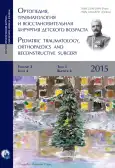Dystrophic epidermolysis bullosa associated with congenital contractures of the upper and lower limbs: literature review
- Authors: Agranovich O.E.1, Buklaev D.S.1, Tikhonenko T.I.1
-
Affiliations:
- The Turner Scientific and Research Institute for Children’s Orthopedics
- Issue: Vol 3, No 4 (2015)
- Pages: 51-59
- Section: Articles
- Submitted: 28.01.2016
- Published: 15.12.2015
- URL: https://journals.eco-vector.com/turner/article/view/967
- DOI: https://doi.org/10.17816/PTORS3451-59
- ID: 967
Cite item
Abstract
About the authors
Olga Evgenievna Agranovich
The Turner Scientific and Research Institute for Children’s Orthopedics
Email: olga_agranovich@yahoo.com
MD, PhD, professor, head of the department of arthrogryposis. The Turner Scientific and Research Institute for Children’s Orthopedics
Dmitry Stepanovich Buklaev
The Turner Scientific and Research Institute for Children’s Orthopedics
Email: dsbukl@mail.ru
MD, PhD, chief of the department of arthrogryposis. The Turner Scientific and Research Institute for Children’s Orthopedics
Tatiana Ivanovna Tikhonenko
The Turner Scientific and Research Institute for Children’s Orthopedics
Email: Tikhonenko_turner@mail.ru
MD, PhD, leading research associate of the department of arthrogryposis. The Turner Scientific and Research Institute for Children’s Orthopedics.
References
- Intong LR, Murrell DF. Inherited epidermolysis bullosa: new diagnostic criteria and classification. Clin Dermatol. 2012;30:70-7. doi: 10.1016/j.clindermatol.2011.03.012.
- Fine JD, Mellerio JE. Extracutaneous manifestations and complications of inherited epidermolysis bullosa. J Am Acad Dermatol. 2009;61:387-402. doi: 10.1016/j.jaad.2009.03.053.
- Fine JD, Eady RA, Bauer EA, et al. The classification of inherited epidermolysis bullosa (EB): report of the Third International Consensus Meeting on Diagnosis and Classification of EB. J Am Acad Dermatol. 2008;58:931-950. doi: 10.1016/j.jaad.2008.02.004.
- Bolling MC, Lemmink HH, Jansen GH, Jonkman MF. Mutations in KRT5 and KRT14 cause epidermolysis bullosa simplex in 75 % of the patients. Br J Dermatol. 2011;164:637-44. doi: 10.1111/j.1365-2133.2010.10146.x.
- Pfendner EG, Bruckner AL. Epidermolysis Bullosa Simplex. Initial Posting: October 7, 1998; Last Update: September 1, 2011. doi: 10.1007/springerreference_35076.
- Pope E, Lara-Corrales I, Mellerio J, et al. A consensus approach to wound care in epidermolysis bullosa. J Am Acad Dermatol. 2012;67:904-17. doi: 10.1016/j.jaad.2012.01.016.
- Fine JD, Bruckner-Tuderman L, Eady RA, et al. Inherited epidermolysis bullosa: Updated recommendations on diagnosis and classification. J Am Acad Dermatol. 2014;70:1103-26. doi: 10.1016/j.jaad.2014.01.903.
- Murrell D. Epidermolysis Bullosa: Part I - Pathogenesis and Clinical Features. 1 ed. Vol. 28-1. Dermatologic Clinics. Elsevier, 2010. doi: 10.1016/j.det.2009.10.020.
- Woodley DT, Chen M. Recessive Dystrophic Epidermolysis Bullosa: Advances in the laboratory leading to new therapies. J of Investigative Dermatology. 2015;135:1705-1707. doi: 10.1038/jid.2015.149.
- Bruckner-Tuderman L. Dystrophic epidermolysis bullosa: pathogenesis and clinical features. Dermatol Clin. 2010;28:107-114. doi: 10.1016/j.det.2009.10.020.
- Soro L, Bartus C, Purcell S. Recessive Dystrophic Epidermolysis Bullosa: A eview of disease: Pathogenesis and update on future therapies. J Clin Aesthet Dermatol. 2015;8(5):41-46. Available from: http://www.ncbi.nlm.nih.gov/pmc/articles/PMC4445895/
- DEBRA International. Available from: http://www.debra-international.org/debra.html
- Liu N, Guo H, Kong X, Shi H, et al. COL7A1 gene mutation analysis of dystrophic epidermolysis bullosa and prenatal diagnosis. Exp Dermatol. 2015;95(4):277-82. PMID: 25877244.
- Swartling C, Karlqvist M, Hymnelius K, et al. Botulinum toxin in the treatment of sweat-worsened foot problems in patients with epidermolysis bullosa simplex and pachyonychia congenita. Br J Dermatol. 2010;163(5):1072-6. doi: 10.1111/j.1365-2133.2010.09927.x.
- Wong T, Gammon L, Liu L, et al. Potential of fibroblast cell therapy for recessive dystrophic epidermolysis bullosa. J Invest Dermatol. 2008;128:2179-89. doi: 10.1038/jid.2008.78.
- Woodley DT, Wang X, Amir M, et al. Intravenously injected recombinant human type VII collagen homes to skin wounds and restores skin integrity of dystrophic epidermolysis bullosa. J Invest Dermatol. 2013;133:1910-3. doi: 10.1038/jid.2013.10.
- Hovnanian A. Systemic protein therapy for recessive dystrophic epidermolysis bullosa: how far are we from clinical translation? J Invest Dermatol. 2013;133(7):1719-21. doi: 10.1038/jid.2013.137.
- Zidorio APC, Dutra ES, Leão DOD, Costa IMC. Nutritional aspects of children and adolescents with epidermolysis bullosa: literature review. An Bras Dermatol. 2015;90(2):217-23. doi: 10.1038/jid.2013.137.
Supplementary files








